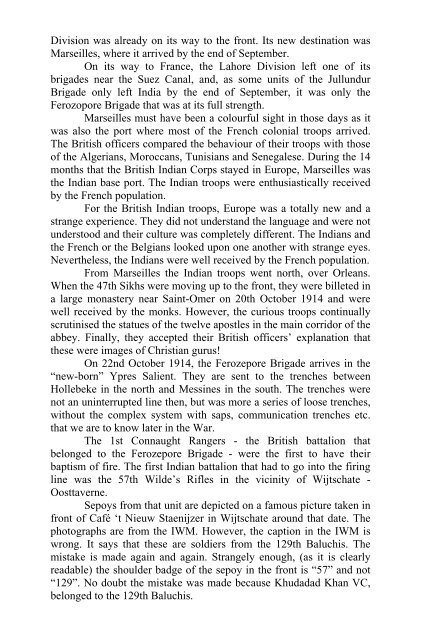HOW EUROPE IS INDEBTED TO THE SIKHS ? - Global Sikh Studies
HOW EUROPE IS INDEBTED TO THE SIKHS ? - Global Sikh Studies
HOW EUROPE IS INDEBTED TO THE SIKHS ? - Global Sikh Studies
Create successful ePaper yourself
Turn your PDF publications into a flip-book with our unique Google optimized e-Paper software.
Division was already on its way to the front. Its new destination was<br />
Marseilles, where it arrived by the end of September.<br />
On its way to France, the Lahore Division left one of its<br />
brigades near the Suez Canal, and, as some units of the Jullundur<br />
Brigade only left India by the end of September, it was only the<br />
Ferozopore Brigade that was at its full strength.<br />
Marseilles must have been a colourful sight in those days as it<br />
was also the port where most of the French colonial troops arrived.<br />
The British officers compared the behaviour of their troops with those<br />
of the Algerians, Moroccans, Tunisians and Senegalese. During the 14<br />
months that the British Indian Corps stayed in Europe, Marseilles was<br />
the Indian base port. The Indian troops were enthusiastically received<br />
by the French population.<br />
For the British Indian troops, Europe was a totally new and a<br />
strange experience. They did not understand the language and were not<br />
understood and their culture was completely different. The Indians and<br />
the French or the Belgians looked upon one another with strange eyes.<br />
Nevertheless, the Indians were well received by the French population.<br />
From Marseilles the Indian troops went north, over Orleans.<br />
When the 47th <strong>Sikh</strong>s were moving up to the front, they were billeted in<br />
a large monastery near Saint-Omer on 20th October 1914 and were<br />
well received by the monks. However, the curious troops continually<br />
scrutinised the statues of the twelve apostles in the main corridor of the<br />
abbey. Finally, they accepted their British officers’ explanation that<br />
these were images of Christian gurus!<br />
On 22nd October 1914, the Ferozepore Brigade arrives in the<br />
“new-born” Ypres Salient. They are sent to the trenches between<br />
Hollebeke in the north and Messines in the south. The trenches were<br />
not an uninterrupted line then, but was more a series of loose trenches,<br />
without the complex system with saps, communication trenches etc.<br />
that we are to know later in the War.<br />
The 1st Connaught Rangers - the British battalion that<br />
belonged to the Ferozepore Brigade - were the first to have their<br />
baptism of fire. The first Indian battalion that had to go into the firing<br />
line was the 57th Wilde’s Rifles in the vicinity of Wijtschate -<br />
Oosttaverne.<br />
Sepoys from that unit are depicted on a famous picture taken in<br />
front of Café ‘t Nieuw Staenijzer in Wijtschate around that date. The<br />
photographs are from the IWM. However, the caption in the IWM is<br />
wrong. It says that these are soldiers from the 129th Baluchis. The<br />
mistake is made again and again. Strangely enough, (as it is clearly<br />
readable) the shoulder badge of the sepoy in the front is “57” and not<br />
“129”. No doubt the mistake was made because Khudadad Khan VC,<br />
belonged to the 129th Baluchis.

















